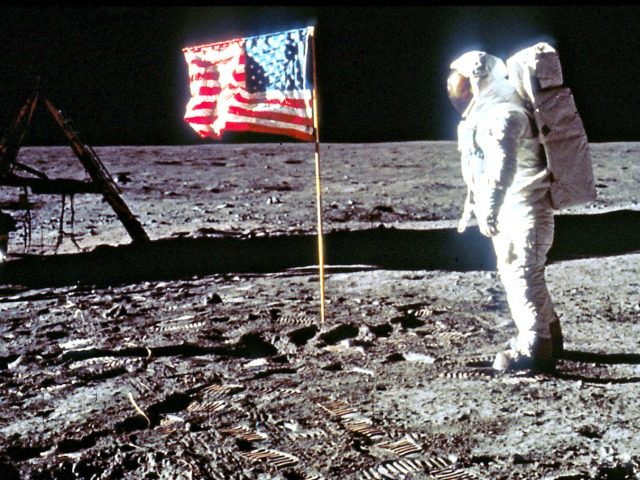National Aeronautics and Space Administration (NASA) Administrator Jim Bridenstine told reporters on a conference call on Monday that the agency is celebrating the 50th anniversary of the Apollo 11 mission to put a man on the moon with a bold prediction about the future of space exploration.
Bridenstine said President Donald Trump wants to “plant an American flag on Mars.”
“The President’s Space Policy Directive-1, it says to utilize the resources of the Moon, and then it says to use the capabilities and the technologies that we develop at the Moon and go on to Mars,” Bridenstine said. “Mars is the goal.”
“The President has been clear,” Bridenstine said. “We want to plant an American flag on Mars.” “That was in his 4th of July speech, which I think was a great reminder of what our ultimate goal is.”
“Yes, we’re going sustainably to the Moon, but we’re doing it so that we can learn how to live and work on another world and take all of that capability and technology on to Mars,” Bridenstine said.
Bridenstine spoke about the historic moon mission at a time when the United States and the Soviet Union were in a “space race” to prove which country was technologically — and otherwise — superior.
“When we think about what the United States was up against in those days, of course, we were at the height of the Cold War, and this was a contest of great powers, namely the United States and the Soviet Union,” Bridenstine said. “And, of course, people are familiar with Sputnik and Yuri Gagarin being the first person in space, but not just the first person in space, also the first person in orbit.”
“The United States was behind, and John F. Kennedy had a vision to get ahead,” Bridenstine said. “That leap-ahead strategy, of course, was an effort to get to the moon, and the United States and the Soviet Union ended up in a space race.”
“The United States at the time was trying to prove that its economic system and its political system were superior to try to get alignment from the rest of the world with us, and ultimately, we achieved the objective, which was to get to the Moon,” Bridenstine said, noting that the United States did a total of six missions to the moon and that twelve men walked on the lunar surface.
And Bridenstine also pointed out that the space race changed to “an amazing achievement of diplomatic capability” as Russia and the United States continue their cooperative space missions for more than 20 years.’
And now the threat to space exploration is one that comes from domestic not international politics.
“There’s two types of risk that NASA deals with,” Bridenstine said. “One type of risk is technical.”
“NASA is very capable of retiring technical risk,” Bridenstine said. “The other type of risk is political.”
“If it wasn’t for the political risk, we would be on the Moon right now,” Bridenstine said. “In fact, we would probably be on Mars right now.”
“In the 1990s, we had the Space Exploration Initiative to go back to the Moon, on to Mars, and it was the political risk that prevented it from happening,” Bridenstine said.
Bridenstine also spoke about the resources on the moon that can benefit the United States, including “hundreds of millions of tons of water ice on the South Pole of the moon” and one-sixth of the gravity as Earth making it easier to launch aircraft from the moon.
“But when we land on the Moon in 2024, between now and then, we have to aggregate a lander in orbit around the Moon at what we call the ‘Gateway,’ which is a small space station that will be in orbit around the moon,” Bridenstine said.
“Gateway is underway,” Bridenstine said. “We’ve gone under contract for the first element, the power, and propulsion element of the Gateway.”
And Trump’s space mission will also advance women in space exploration. “It just so happens that in Greek mythology, Apollo had a twin sister,” Bridenstine said. “Her name was Artemis, and Artemis happened to be the Goddess of the Moon.”
“So now here we are a generation later, ready to go back to the Moon sustainably, with an eye for what the objective is,” Bridenstine said. “The objective is Mars, but we’re going back to the Moon sustainably with a very diverse, highly qualified astronaut corps that includes women under a program named after the twin sister of Apollo, Artemis.”
“I think having women astronauts on the moon is something that is long overdue, and we look forward to working with members of Congress to help us achieve the end state which, of course, is landing on the South Pole of the Moon by 2024, retiring the risk technologically so that we can go on to Mars,” Bridenstine said.
Follow Penny Starr on Twitter.

COMMENTS
Please let us know if you're having issues with commenting.